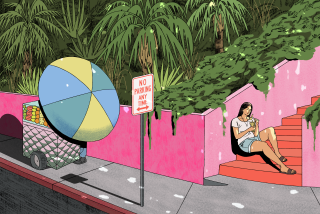Lessons of the Past : Whether Martin Luther King’s Death or ’92 Riots, April Anniversaries Highlight Challenges for Diverse L.A.
This month marks two significant anniversaries that prompt me to reflect on the state of human relations in Los Angeles. April 4 marked the 27th anniversary of Martin Luther King Jr.’s assassination. Yesterday, April 29, marked the third anniversary of the civil unrest. The dates remind us of cataclysmic events that highlight the challenges of different people living together.
On April 3, 1968, Martin Luther King Jr. gave a sermon in Memphis, Tenn., entitled, “I See the Promised Land.” His speech followed the themes of his life, namely, a commitment to nonviolence, social justice and racial equality. He said, “We’re going to have to grapple with the problems that men have been grappling with through history.”
Dr. King understood the difficulty of fighting for social justice and fostering positive human relations. He also understood the personal peril, as he described the threats against his life and implied strongly that he knew he would soon be killed. He was assassinated the following day.
The problem of respecting and living peacefully with others different from ourselves is clearest in our beloved Los Angeles. We are a great multicultural city in transition, and our human capital is a distinctive asset. We are a salad bowl of people, avowed to be the most diverse in the world. The riches and variety of talent, energy, skills, languages and cultures must be harnessed to create a synergy that will propel Los Angeles forward. But there is tension in L.A.’s salad bowl.
The signs are all around us--from the San Fernando Valley to South Los Angeles to San Pedro. The diversity we celebrate and applaud in public-relations promotions for our city and state is really used as a scapegoat issue by many to explain our nearly bankrupt economic coffers. Our economic downturn (which is national in scope), a still-climbing national debt, soaring unemployment, escalating violence and plummeting educational scores, are often blamed on various sectors of our population, from immigrants to natives.
What can we do to help ensure that Los Angeles’ diversity is recognized as our greatest strength rather than our greatest weakness? A prospering economy and a safer city will obviously lessen the tension. We continue our efforts in these areas, but even their achievement will not produce tranquillity. The issue is a difficult and complex one. We all need to develop solutions. For my part, I offer three steps that can take us down a positive path:
First, we must maintain civil rights laws that are responsible, and provide diligent oversight to ensure they are administered fairly. Fair implementation is essential, otherwise people will witness others cheating the system and/or experience their own rights being violated. Our system of laws is dynamic and allows constant refinement, but adoption of wholly new laws--for example, in the area of affirmative action--requires careful deliberation. A leaking pipeline can be serviced without resorting to blowing up the entire system.
In this regard, politicians and advocates have a responsibility to not stoop to demagoguery and knee-jerk reactions, or the outcomes will be ill-conceived and give birth to a new reconfigured class of disenfranchised people.
Second, the city needs to restructure and expand its Human Relations Commission. Los Angeles is the nation’s second-largest city, with a population of over 3.5 million and an annual budget of over $4 billion--yet the present commission has only two full-time staffers and a budget of $100,000!
The commission’s role must be more clearly defined and accountability explicitly delineated. It needs a larger staff and more resources. We need a stronger mechanism to build communication bridges connecting people and communities. We must find the funds to do so. The private sector can help in this effort by volunteering pro bono services, loaned staff and monetary donations.
Third, the community can do its part toward fostering good human relations. Religious institutions--churches, synagogues, mosques, and temples--schools and other organizations can teach cross-cultural awareness, sponsor social events attended by diverse groups, conduct English as a Second Language (ESL) classes for immigrants, and teach mediation and dispute resolution courses, as a start. They can also establish centers for positive community interaction (e.g., parenting, sports, day-care). Good things can happen!
Exactly a year ago, junior high school students from Malibu and South-Central learned through interchange over their local tragedies. After Malibu’s devastating fire, the South-Central students went to the seaside town to plant trees. The Malibu students reciprocated by coming to South-Central to plant trees in an area hit hard during the civil unrest. The seeds of goodwill can be planted throughout the city.
We are a great multicultural city in transition. There is much stirring in the L.A. Basin, our geographic bowl that serves as our giant meeting room. In concluding his last sermon 27 years ago, Martin Luther King Jr. said that he had been to the mountaintop and had seen the promised land. Los Angeles is far from being the promised land, but no other city holds greater people, potential and promise.
More to Read
Sign up for Essential California
The most important California stories and recommendations in your inbox every morning.
You may occasionally receive promotional content from the Los Angeles Times.










